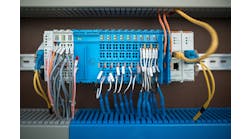Rockwell Automation defines the necessary "smart" technology in several ways, said Pritchard. "For example, many of our devices now use standard EtherNet/IP networking technology, all the way from the machine control on up to the enterprise level. Smartness also comes from our Logix control engine, which is used in all of our controllers, regardless of discipline or scale. Although deployed in different hardware form factors depending on the application, the engine is multidisciplinary, providing safety, process and motion capabilities via international standard programming languages including function blocks, structured tags and ladder logic, among others. Because the controllers all use the same engine, there is only one design environment, which makes for an efficient approach—engineers don't have to settle on one language for an entire project, for instance," explained Pritchard.
Smartness also comes from devices that support manufacturing productivity by gathering and displaying data and contextualizing it to give personnel the information they need to understand what is going on and make good decisions, continued Pritchard. "We call this concept 'reducing the cost of curiosity.' In other words, instead of having to go to a manager, make a request and two weeks later get a KPI report, you can now just create a mashup report immediately on a mobile device."
John Pritchard of Rockwell Automation treated Automation Fair visitors to a tour of enabling technologies for The Connected Enterprise.
Smartness aside, security also tops the industrial hot topic list, and Rockwell Automation provides a smorgasbord of devices to address this issue, said Pritchard. "First, though, it is important to understand there is no silver bullet in regards to automation security; the area is complex and evolving,” he said. “Our advice is to deploy a 'defense in depth' approach, meaning you approach security across several different levels in your organization. These could include physical security, software or device-based technologies."Security can be as simple and straightforward as keeping your network assets in a physical, locked box,” he said. “For example, Panduit products on display in this booth have a feature called lock-in-block-out, which keeps the cable in the port it is meant to be in and makes it hard to pull out. Our managed switch features Cisco technology that switches off the ports not being used, as well as creating unique IP assignments so only the right cable can be plugged in, or it won't be able to pick up an address."
Taking networking security up a notch is an industrial firewall with VPN capability. "Typically, firewalls are placed between an enterprise and the outside world. Our firewall is dropped directly into the control panel, letting companies protect zones of critical machinery." The VPN capability lets users tunnel through otherwise insecure networks and create a secure connection to remotely monitor a machine.
And software is obviously critical to support security in The Connected Enterprise. "Consider for example, our FactoryTalk Security software and FactoryTalk AssetCentre program," said Pritchard. "The first assigns the proper personnel rights, such as being able to access certain control functions or change codes, while the latter is all about change management control. It keeps track of who has made changes, logs in the latest version of the code, and if somebody has made a change, what it was and why they made it. The fringe benefit is when you must pull out an asset or a machine and bring in a new one, you don't have to run around trying to figure out the level of configurations and what programs were running. Just use theFactoryTalk AssetCentre server and redeploy everything back to the way it was."
Also important is Studio 5000 Logix Designer v24 software, which is used to do all the programming of
Rockwell Automation Logix controllers. "The program has new features that support automation productivity and, thus, helps support one of the goals of The Connected Enterprise," said Pritchard. "For example, it includes new ways to show the application code. Depending on your job function, you might view the world slightly differently. Control engineers tend to think in terms of controlling the process or scheduling tasks, so you want to do your code in that way. On the other hand, maintenance personnel tend to think of things in terms of tank #1, machine #2 and filler #3. The new feature lets users view the same code in different ways, and these can be switched dynamically."
Rockwell Automation also has done a lot of work around modular programming techniques to support best practices in The Connected Enterprise, said Pritchard. "When an engineer comes up with a nice block of code that does something like initialize a machine, you want to capture the code so you can do it the same way each time and save unnecessary effort. Another feature is what we call 'compare' mode. Imagine you have worked on a project and then someone else works on it later. You come in the next morning, say, and want to know what changes the individual made. When two people have made the same change, you can decide which will be the best one. The feature is a nice way to rack and stack through the program and see what the changes were, and then merge the bits of code so you get back to one project file. This collaboration gets projects done faster and faster."




